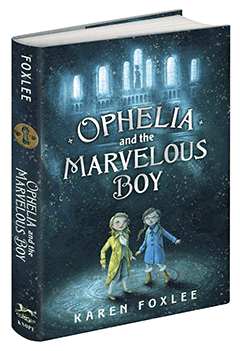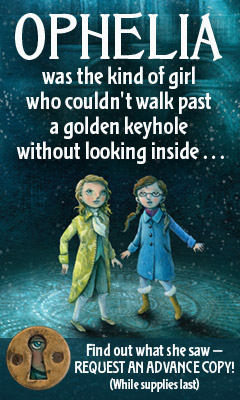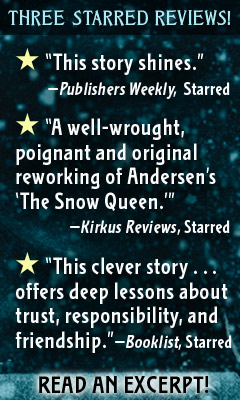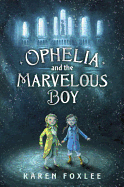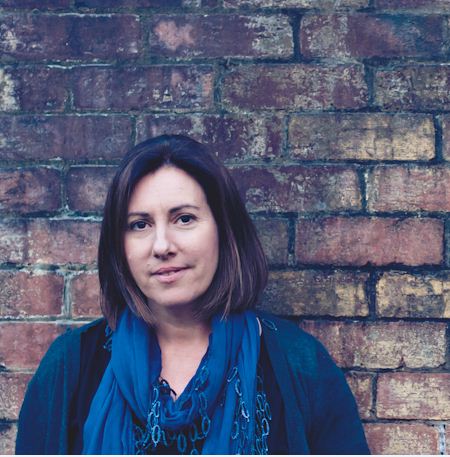Ophelia and the Marvelous Boy
by Karen Foxlee
In this captivatingly original variation on Hans Christian Andersen's "The Snow Queen," Karen Foxlee (The Anatomy of Wings) threads themes of grief, friendship and faith into a suspenseful adventure in a cavernous museum.
A Boy, wrenched from his family because he fulfilled a prophecy from the wizards in his homeland, travels on a quest to a distant kingdom to save his people from the Snow Queen. Armed with a rudimentary sword, he can vanquish the powerful Queen, who turns everything to ice, from majestic trees to human hearts. A magical owl's charm helps the Boy on his journey to the faraway land, where he befriends a child King. They become faithful companions. The owl's charm, however, causes the Boy to remain a child, while the King ages. The monarch names his friend his Marvelous Boy, yet neglects him when a beautiful and mysterious woman arrives. The King marries her, and as his land turns to snow and ice, his Queen convinces him to imprison the Boy. ("We shall lock him away," urges the Queen. "He shall be displayed beside all the other precious things; he is a curiosity. I will feel safer.")
Now nearly 300 years later, 11-year-old Ophelia Jane Worthington-Whittard comes upon the Boy in a museum where her father, a sword expert, assembles an exhibit. The Wintertide Clock tracks the countdown to Christmas Eve, just three days away--the opening of the exhibit and the deadline for the Marvelous Boy to defeat the Queen. Foxlee creates in Ophelia a practical, logical heroine, a member of the Children's Science Society of Greater London. "Ophelia didn't consider herself brave but she was very curious," begins the main action of the novel, and with this first line, Foxlee spells out the heroine's inner struggle. Curiosity leads Ophelia to room 303, on the museum's third floor, where she discovers a keyhole, a blue-green eye on the other side, and a voice to go with it. "Who are you?" a startled Ophelia asks. " 'I don't have a name,' said the voice. 'It was taken from me by a protectorate of wizards from the east, west, and middle to keep me safe.' " Ophelia replies, "But I don't believe in wizards."
Foxlee's greatest achievement lies in the building of Ophelia's gradual willingness to venture outside her comfort zone and to accept things she would not ordinarily believe. Like Gerda in Andersen's version, Ophelia must embark on a journey, but it is an inner journey to a faith beyond facts, more than the physical journey through the museum's floors in search of the three keys that will set the Boy free and the sword he needs to complete his mission. Foxlee's Boy remains kind and compassionate--a companion spiritually and psychologically to Ophelia--while Ophelia's sister, Alice, takes on the role of Kai in Andersen's tale. Alice has begun to harden toward Ophelia ("ever since their mother died, which was exactly three months, seven days, and nine hours ago"). The sisters' grief over the loss of their mother takes hold in different ways. Alice, on the cusp of adolescence, falls under the influence of the beautiful curator, wearing lipstick and borrowing luxurious clothes from the museum's collection at the curator's urging. Ophelia undertakes the fight of her life to save the Boy.
Foxlee builds suspense through Ophelia's initial reluctance to believe the Boy, and no wonder Ophelia is dubious: "The trouble with magic was that it was messy and dangerous and filled with longing." The author invents fantastically frightening forces lurking in the museum, such as misery birds, ghostly girls (victims of the Queen's charms) and, most terrifying of all, the wicked curator herself. Ophelia and the Boy are the only ones who recognize her for who she is; Ophelia's father and sister fall under the wicked woman's spell. But the growing friendship between Ophelia and the Boy, and her gradual willingness to believe in the Boy's story, balance the fearful elements of the novel.
Ophelia's slow but steady awakening to the existence of magic in the world helps her integrate for herself the characteristics in her mother that once separated them. She sees that by opening herself to these possibilities, she keeps her mother close. Foxlee wisely equates the Boy's grief at the possibility of the destruction of the world--if they do not defeat the Queen in time--with the grief for Ophelia's mother that threatens to destroy her family. And Ophelia's family is her world. Through Ophelia's friendship with the Boy, they both begin to heal--the Boy by telling his story, and Ophelia by claiming new parts of herself that she shares with her mother. Splendid. --Jennifer M. Brown



